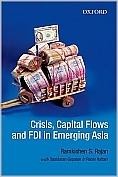| |||||
• polskie
• Zamów informacje o nowościach z wybranego tematu • kontakt |
CRISIS CAPITAL FLOWS AND FDI IN EMERGING ASIARAMKISHEN RAJAN SASIDARAN GOPALAN RABIN HATTARIwydawnictwo: OXFORD UP, 2011, wydanie Icena netto: There has been much interest in understanding various dimensions of the growth and integration of emerging Asia with the rest of the world, particularly with regard to international capital flows and external financing. Nonetheless, serious academic work in this area has lagged somewhat compared to issues relating to international trade. This book fills this gap by dealing with topics relating to booms and busts in capital flows, financial stability the sources of external financing, and the important role played by FDI. It also discusses the monetary transmission channel, extent of financial integration, and the choice of exchange rate regimes in emerging Asia. The book consists of ten chapters, divided into three sections pertaining to international capital flows and financial crises; foreign direct investment (FDI) flows to and from the region including Mergers and Acquisitions (M&As), exchange rate regimes and choices and monetary policy transmission mechanism. While some chapters focus specifically on India, which is one of the new growth stars of Asia, many chapters deal with emerging Asia more generally (or specific sub-regions of East and South Asia). The book focuses on important economic policy issues of contemporary relevance-informed by data and rigorous empirical analysis. Table of Contents Preface 336 pages, Paperback Księgarnia nie działa. Nie odpowiadamy na pytania i nie realizujemy zamówien. Do odwolania !. |


